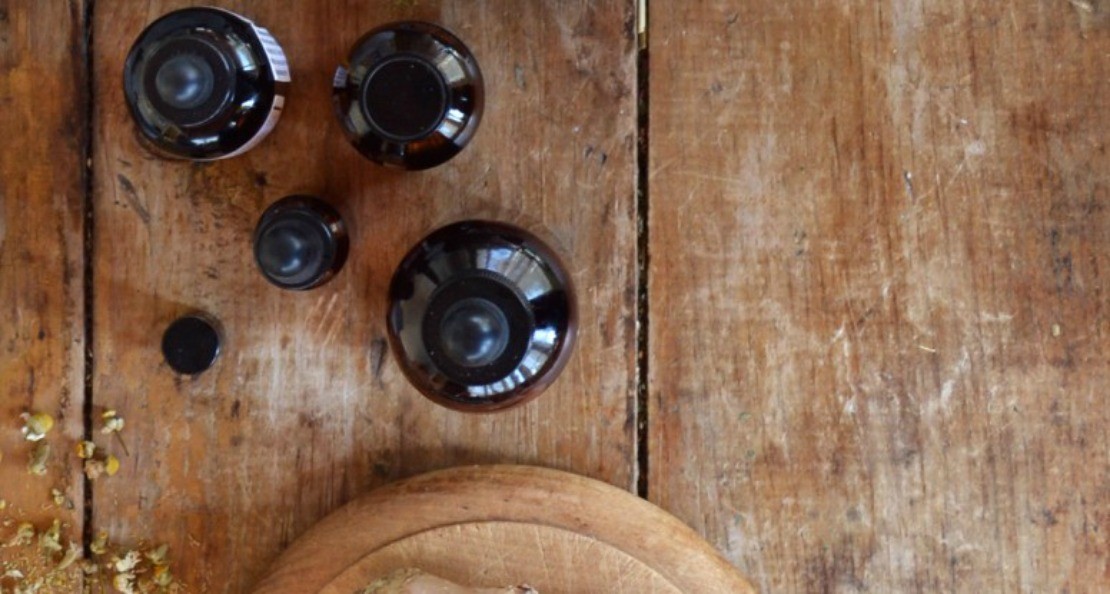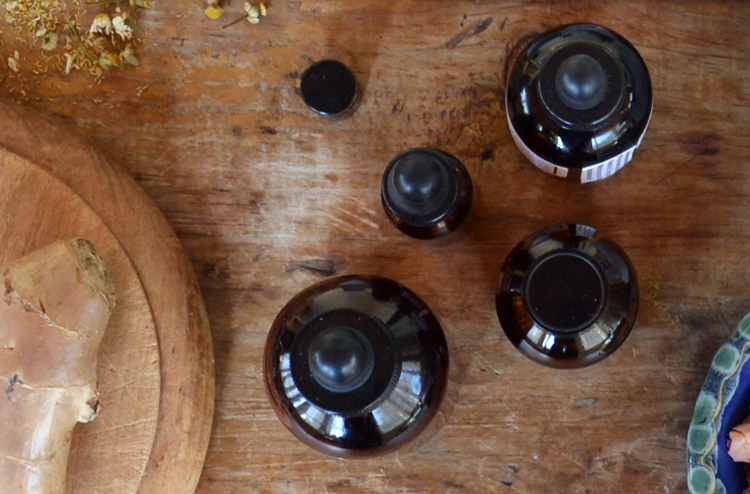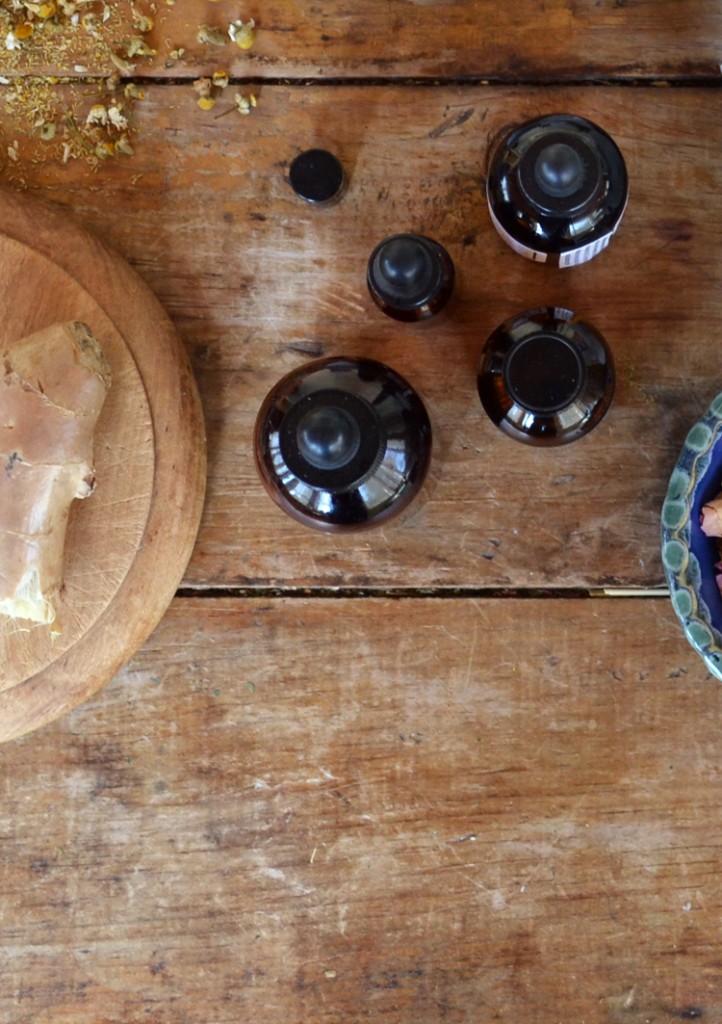
Basic Essential Oils for Daily Living
This post is the first in a weekly, multi-part series on using essential oils. Here we will start with some basic essential oils. What are essential oils? How can you use essential oils? Which essential oils could you start with? We invite you to learn some basics here and then join us weekly for additional articles on topics ranging from choosing high quality essential oils and essential oil safety to using essential oils in herbalism.
Essential Oil Origins
The term “aromatherapy” often elicits images of scented candles or body lotions that are supposed to make us feel calmer or cheerier or make our air smell fresher. Although the term is relatively new, coined in 1928 by Frenchman Rene’-Maurice Gattfosse’, people of many cultures around the world have used aromatic plant extracts for beauty products, perfumes, spiritual or political rituals, and physical or emotional well-being for millennia. Historically, aromatic compounds were often extracted by infusing the herbs in vegetable oils and other such substances. Distilled essential oils similar to what we use today were first developed sometime around the 11th century.
True aromatherapy, as the term was originally used, describes the use of essential oils and other volatile plant compounds for physical and emotional or psychological wellness. There are four primary means of extracting these aromatic compounds from the plants to produce what are commonly known as essential oils: steam distillation, mechanical expression, solvent extraction, and carbon dioxide (CO2) extraction. Only distillation and mechanical expression produce true essential oils, although products from the other methods, called absolutes and CO2 extracts, are used in similar ways.

The majority of the many (sometimes hundreds) of constituents in essential oils are produced by the plants either for their own protection, to attract pollinators, or to heal wounds. A few of the chemicals found in essential oils are products of the extraction process itself. These new constituents and the highly concentrated nature of essential oils are what make them different from other herbal products and also sets them apart from fragrance or flavoring extracts.
We call them “oils” because of their lipophilic, or fat-loving, nature as they will mix easily with fats and oils, but essential oils are not made up of lipids. They have no nutritional value and their therapeutic actions and safety concerns are often different than those of their herbal counterparts.
An Essential Oil Starter Kit
As any one essential oil can contain hundreds of different chemicals, each essential oil has multiple physical and emotional effects. This makes it easy to build a simple starter kit that can address a variety of wellness needs. Most essential oils have long shelf-lives as well, making them excellent for survival kits. If you are wondering where to find and purchase high quality essential oils, keep an eye open for an upcoming article on that very topic. Some essential oils to have on hand for basic, daily needs are:
- Lavender (Lavandula angustifolia)
- Tea tree (Melaleuca alternifolia)
- Sweet Orange or Wild Orange (Citrus sinensis)
- Peppermint (Mentha x piperita) (not recommended for children under age 6)
When in doubt, or if you are not sure what might apply in any given situation, lavender is the first oil to reach for.

How to Use Essential Oils
Essential oils are used three different ways: aromatically (by inhalation), topically, and internally. Internal use, or direct ingestion of essential oils, is a growing practice among new essential oil users. It carries the highest risk and should only be done under the guidance of someone specifically trained in the internal use of essential oils and how those oils behave in the body. Children under age 6 and pregnant women should not ingest essential oils. Aromatic and topical applications use are powerful and effective for daily health and wellness.
Aromatic use often employs use of a diffuser, but it also can be as simple as smelling directly from the bottle, putting a drop on a tissue or cotton ball and allowing the drop to diffuse, or inhaling directly from the tissue or cotton ball. For topical use, the essential oil is diluted in some kind of carrier, usually a vegetable oil (e.g. sweet almond oil, fractionated coconut oil, or jojoba oil), aloe vera gel, lotion, or cream; in a pinch, grab the olive oil from the kitchen to use as a carrier oil. As essential oils are highly concentrated, “neat” (undiluted) use on the skin increases the risk of a negative skin reaction and should be used only in a few rare circumstances.
One approach to essential oil use is to look at daily life through three lenses:
- nourishing vital energy or wellness
- protecting vital energy or wellness
- restoring vital energy or wellness
Nourishing vital energy
Nourishing vital energy includes daily use or for chronic health challenges.
- Uplift: Diffuse sweet orange essential oil to uplift emotions; mix three (3) drops each of lavender and sweet orange in one ounce (30ml) of unscented lotion for a skin-friendly, uplifting hand and face lotion.
- Relaxation: Place a tissue with a drop of lavender on it next to your pillow to relax and fall asleep. Mix five (5) drops of lavender in ½ teaspoon of carrier oil. Add this to one ounce (30ml) of Epsom salts or Himalayan pink salts for a relaxing bath before bedtime or after working out. Lavender can be added to other bath recipes as well, like this soothing oatmeal bath.
- Body Care: The options for making unique, natural beauty and cosmetic products are virtually endless. Check out some of our favorite body care recipes with various essential oils including bath salts, body butter, sugar scrubs, and body cream.
Protecting vital energy
Protecting vital energy means protection from a direct health threat. Essential oils are excellent, non-toxic, green cleaning ingredients and many have antimicrobial properties.
- Cleaning Spray: In a two ounce spray bottle, mix 1.5 ounces of water with a dash of white vinegar, along with five (5) drops each sweet orange, tea tree, and peppermint (or lavender.) Shake well before use.
- Hand Sanitizer: Mix five (5) drops each of peppermint, tea tree, and sweet orange with one (1) ounce (30ml) of aloe vera gel in a flip-top PET plastic bottle The number of drops of each of the oils can be changed; the total number of drops should be 15-20. Take this with you when you travel.
- Immune Strengthening: Diffuse or inhale sweet orange and lavender frequently to strengthen the immune system and decrease stress at home, in the workplace, or when traveling.
- Deter Pests: Mix two (2) cups water with about one (1) teaspoon of dish soap in a 16 oz spray bottle. Add 5-7 drops of tea tree, sweet orange, or peppermint essential oil, or a combination of those oils that smells good to you, shake well, and spray it around doorways and other areas where spiders reside and insects come in. Peppermint can drive away aphids and other insect pests from your garden plants. Use 1 drop per ounce of water and spray your plants once a week.
Restoring vital energy
Restoring wellness is necessary when there has been an injury or illness.
- Bee sting, bug bite, or burn: Dilute 6 drops of lavender essential oil in 1/2 ounce of carrier oil or herbal infused oil and apply to soothe the itch or pain and speed healing. Or try one of these recipes for natural bug repellents.
- Itch relief: Blend 5-6 drops of lavender in one (1) ounce (30 ml) unscented lotion, aloe vera gel, or a carrier oil and apply to skin to ease itchiness.
- Headache: Inhale lavender and/or peppermint directly; or mix 1-5 drops of peppermint alone or 2-3 drops of peppermint plus 3-7 drops of lavender into one (1) ounce of fractionated coconut oil or unscented lotion and apply to the back of the neck and to the temples. (Note that peppermint can cause a burning sensation when too much is applied, and different people may have differing sensitivities to topical use of peppermint.)
- Bruises and Swelling: Mix a total of 14 drops of peppermint and lavender in unscented lotion or other carrier oil and apply several times a day to ease discomfort.
- Nausea: Inhaling peppermint can ease nausea.
- Stuffy Nose: Children over age six (6) and adults can inhale peppermint. Younger children could inhale lavender and sweet orange for immune support and to relieve stuffiness. This decongesting salt steam is also one to try.
Storage and Basic Safety
Essential oils are best stored in a closed bottle, out of direct sunlight in a cool place, and out of reach of children and pets. Never put an essential oil inside eyes, nose, or ears. Dilute the essential oils appropriately, according to recommended safety guidelines. For children ages five (5) and under, infused oils, hydrosols, and herbs are a better choice than essential oils for addressing health and wellness. Diffusing essential oils in the house is fairly safe for our furry friends, but more caution must be exercised around pet birds.
Recommended Resources
- Andrea Butje’s Essential Living is a good place to start understanding essential oils better and trying out some new recipes.
- Keville, Kathi, and Mindy Green. (2008). Aromatherapy: A Complete Guide to the Healing Art. (2nd Ed.). New York: Crossings Press.
- Schnaubelt, Kurt.(2011). The Healing Intelligence of Essential Oils. Vermont: Healing Arts Press.
- Tisserand, Robert and Rodney Young. (2014). Essential Oil Safety. (2nd Ed.). London: Elsevier.
- The AromaWeb website at www.aromaweb.com has articles on all aspects of aromatherapy, as well as links to many retailers.
- The National Association for Holistic Aromatherapy at www.naha.org is a professional organization for those who use essential oils. They also have resources and lists of schools and essential oil suppliers on their website.
- Robert Tisserand, one of the co-authors of Essential Oil Safety, is very highly respected in the aromatherapy field. He often debunks rumors and myths on his blog, as well as providing links to scientific studies to support his assertions. http://roberttisserand.com/blog/
- Curious about using essential oils with children? Read the Herbal Academy of New England’s blog post on the topic here.









